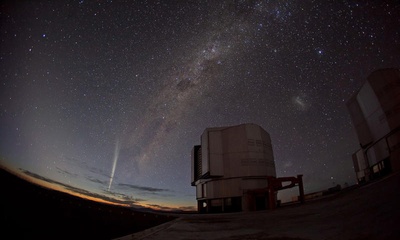Christmas Comet Lovejoy Captured at Paranal Observatory in Chile
A new time-lapse video sequence was taken by Gabriel Brammer from ESO less than two days ago on Dec. 22, 2011. Gabriel was finishing his shift as support astronomer at the Paranal Observatory when Comet Lovejoy rose over the horizon just before dawn.
In the words of Gabriel Brammer himself: "On the last morning of my shift I tried to try catch it on camera before sunrise. The tail of the comet was easily visible with the naked eye, and the combination of the crescent Moon, comet, Milky Way and the laser guide star was nearly as impressive to the naked eye as it appears in the long-exposure photos."
The sequence also features the pencil-thin beam of the VLT's Laser Guide Star set against the beautiful backdrop of the Milky Way, as astronomers conduct their last observations for the night.
ESO optician Guillaume Blanchard made a marvellous wide-angle photo of Comet Lovejoy and ESO Photo Ambassador Yuri Beletsky, captured the spectacle from Santiago de Chile. Blanchard said: "For me this comet is a Christmas present to the people who will stay at Paranal over Christmas."
This bright comet was also seen from the International Space Station in another stunning time-lapse sequence on Dec. 21 as the crew filmed lightning on Earth's night side (see: http://www.nasa.gov/multimedia/videogallery/index.html?media_id=125774121).
Comet Lovejoy has been the talk of the astronomy community over the past few weeks. It was discovered Nov. 27 by the Australian amateur astronomer Terry Lovejoy and was classified as a Kreutz sungrazer, with its orbit taking it very close to the Sun. (Kreutz sungrazers are members of a family of comets thought to come from the break up of one single large comet in the 12th century, and which now orbit the Sun along the same path.) Just last week, the comet entered the Sun's corona, a much-anticipated event, passing a mere 140,000 kilometres from the Sun's surface. A close shave indeed...
The comet was expected to break up and vaporise, but instead it survived its steaming hot encounter with the Sun and re-emerged a few days later, much to everyone's surprise. It is now visible from the southern hemisphere, appearing at dawn, and features a bright tail millions of kilometres long, composed of dust particles that are being blown ahead of the comet by the solar wind.
Lovejoy will now continue in its highly eccentric orbit around the Sun and once again disappear into the distant Solar System. It would be interesting to know if it will actually survive to re-appear in our skies in 314 years as predicted.
